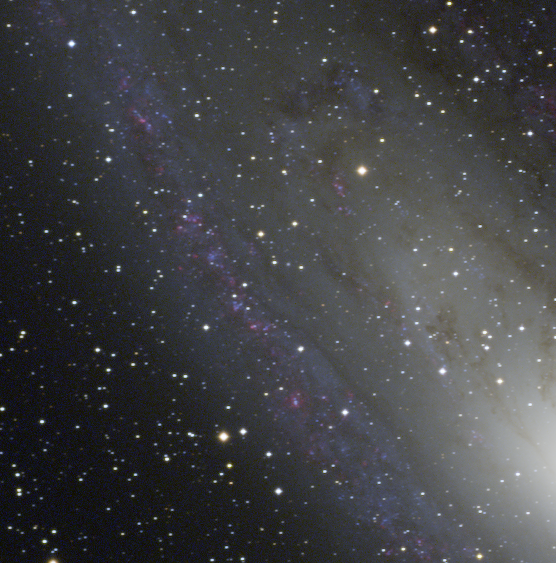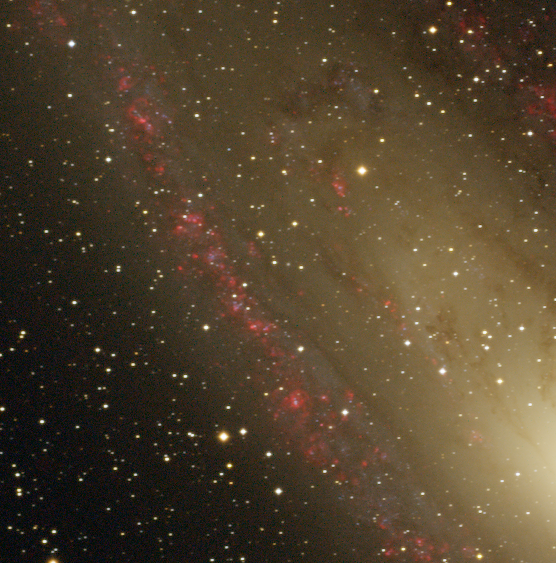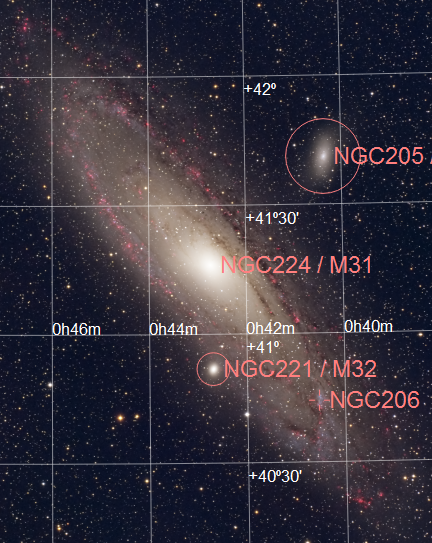The full size image shows the structure of the spiral in more detail.
Note also NGC 206. For comparison here is a closeup using a larger scope.
| Rob Hawley's Pages | Almaden Observatory Main Page |
July
- September 2013
This image is displayed at half resolution (~ 7"/pixel).
|
Click
on the image above for a full size image.
The full size image shows the structure of the spiral in more detail. Note also NGC 206. For comparison here is a closeup using a larger scope. |
Filter
Exposure
Number of Images
sV (Strömgren V)
900
33
sYel (Strömgren Y)
900
31
20nm Hydrogen (Ha20)
900
28
3nm Hydrogen
900
31
All filters were Astrodon
Note: During the 2014
Katonah
NY workshop Vicent updated the equations he uses. See 16M81/M82
Before  This shows the rather flat appearance of the RGB before adding Ha. At this point Color Calibration has not been done. The Ha20 filter will collect more hydrogen relative to its bandwidth than a conventional R filter. Thus the star forming regions are just starting to show. |
After  Adding the 3nm Ha makes the star forming regions pop. At this point the image is a bit red. That will be corrected in later steps. |
To insure that stars are the correct colors one images a reference G2V (i.e. sun like) star. You then balance the colors so this star appears white. I shot M31 in a wide swath of sky so no single calibration was going to be perfect. I tried letting Pixinsight calibrate via structure detection, but that did not give good results. Thus I used a color calibration for a star that is high in the sky (since almost all images were shot about 50 degrees elevation).
For this project I used HIP 96037. From this I determined that the
correction should be
Ha20
0.38
sYel
0.26
sV
1.0
These were used for color correction in PixInsight. The initial color correction worked well with the galaxy mostly a white color with a slight red tinge. However, after stretching the galaxy got a yellow tint (too little blue). I removed this using a masked CurvesTransformation that increased the blue.
How accurate are the star colors? For comparison here is an version of the image with the BV Index of the stars annotated. The reader can decide for himself if the colors are accurate.
Once color calibration was done I used TGVDenoise to reduce the noise in the background. I was happy with the stars so I did not bother using deconvolution .
So far the image had been linear. I used a simple HT to stretch it.
I was not happy with the results when I tried a masked stretch.
A lot of structure was apparent even at this point. To make sure
the final image did not look over processed I used the sharping tools very
judiciously.The first is HDRMultiScaleTranform which spreads the
brightness over a wider range of values. I then added a bit of
DarkStructureEnhance and LocalHistogramEquilization.
Finally I used MMT to further sharpen the structures the previous steps
disclosed. Then another pass of TGVDenoise to remove the last noise.

